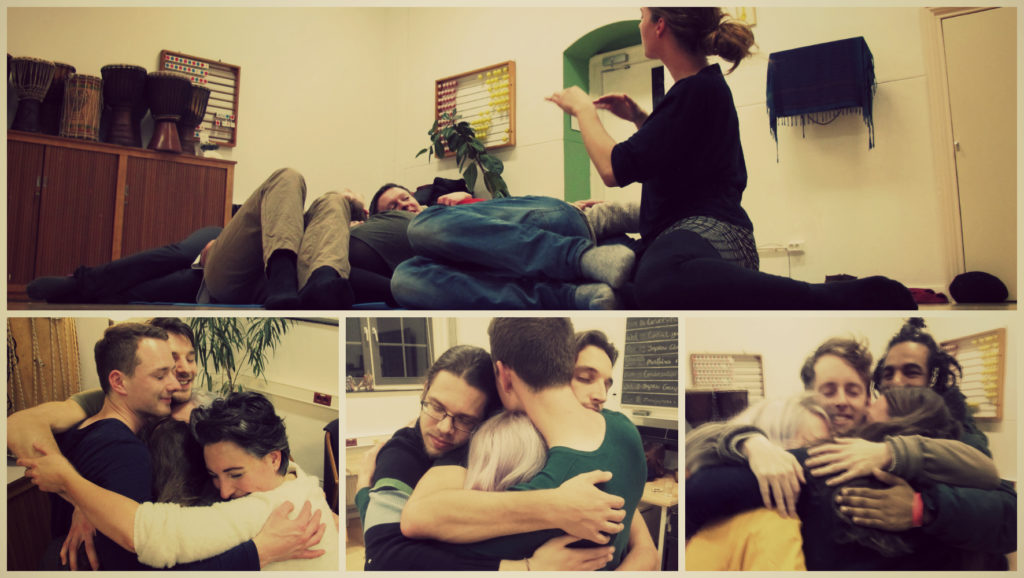Oxytocin
A number of ‘oxytocin workshops’ took place in 2019 at Centrum Vaktherapie in Maastricht. The aim of these meetings was to share knowledge with the participants about the chemistry of the body and teach them how to consciously influence our physiological processes. This article is for anyone who wants to know more about this subject.
Nothing in biology makes sense except in the light of evolution’. – T. Dobzhansky. This quote may sound a little vague and conceptual. But only when you learn how processes in the body work, you can understand why our bodies do what they do. We must look at the circumstances in which these processes have been installed and how they have developed further. Let’s take a closer look at the hormone oxytocin through this evolutionary lens.
We all know that man is a social being. But what does this actually mean? Because in order to survive, we don’t necessarily need other people anymore. We are able to walk to the supermarket to get our food and most people can at least prepare an egg without any help. If we are looking out for our safety we might sooner be inclined to stay away from others than to seek them out. We can also organise heat and protection against the weather ourselves. As soon as you close the front door behind you and open the heating system, it’s settled.
Imagine how you would manage all this if you were to be placed all alone in a forest. During most of human evolution, isolating yourself from the group meant that you were at enormous risk of dying. It is, for example, not easy to protect yourself from larger, stronger animals.
This means that people who were more inclined to stay with the group and maintain social contacts could reproduce more successfully. All kinds of systems have developed generation after generation to make connections with other people rewarding. One of the central substances in these systems is oxytocin. This is produced when we feel connected to someone else. And the interaction that oxytocin has with other substances such as dopamine and serotonin makes us feel great. If something feels good we will be more inclined to repeat the behaviour that produces the feeling and our genes will direct us towards the behaviour that work to our advantage.

Loneliness
You can also imagine that loneliness is therefore a problem for us humans. Especially since for our brains there is no difference between the feeling of loneliness and literally being alone. So when you stand at a party between people and feel lonely it is as if you are really alone for the brain. This feeling of being alone should lead to a movement. Every homeostatic feeling that is produced can be seen as the brain ringing the bell. They have found a problem and are asking for an action to solve it. Unfortunately, loneliness is a state in which we often get frozen and then want to suppress or numb it with things like alcohol, cigarettes, obsessively watching TV or staring at Facebook.
To help get back into action and feel how oxytocinergic compound feels we started giving oxytocin workshops. It is wonderful to see how people who are strangers to each other can enjoy the connection that arises in just two hours. And once we’ve felt how rewarding this contact is, we get the natural tendency seek it out in our lives, with all the benefits that come with this.
Exercises
Here are a number of exercises that, when you feel safe, stimulate your oxytocin production.
1. Ask another person for a small massage, the touch and pressure on the other person’s body causes oxytocin production. The effect can be enhanced when you feel more connected to the other person. It can help to think carefully about where and how you want to be massaged and to share this with the other person. When the other person gives you a massage that exactly matches your needs and responds to your request, the feeling of connection is strengthened. If you massage directly on the skin of the other person the production of oxytocin is higher because your body can register that there is interpersonal contact even better. Do you really want a bog dose of oxytocin? You can synchronise your breathing during the massage, increasing the feeling of connection.
2. Mindful hugging. Oxytocin is nicknamed ‘the cuddly hormone’ with good reason. Here the duration and how much you can relax in the embrace is important. When you cuddle, you can reflect on the body sensations you notice. Does your heart rate go down when you cuddle longer, for example? It’s nice to try out different types of cuddly types with a few others, the more you can exchange the more oxytocin.
3. Eye contact! It’s not just touching that makes you feel blissful, you can also feel connected to someone else by talking (even getting messages on your smartphone slightly initiates the oxytocin production) or through eye contact. Take a little break from talking and doing together and set a timer. Then gaze into eachothers eyes for a few minutes. Here you can enhance the effect by breathing synchronously again.

Latona Bekker works with people around (chronic) physiological problems. She uses her knowledge of the immune system, the functioning of the brain and the psychology of the human being in her treatment. She looks at problems both in detail and holistically using recent scientific research.

Orthomolecular Therapy and Clinical Psycho- Neuro- Immunology
